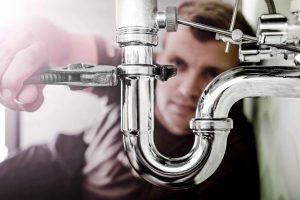 Although not a common task, draining your home’s plumbing pipes is occasionally necessary. Some common reasons for doing this include:
Although not a common task, draining your home’s plumbing pipes is occasionally necessary. Some common reasons for doing this include:
- Fixing a water hammer problem.
- Shutting down a seasonal property for the winter.
- To make major plumbing repairs, like replacement of main plumbing lines.
Seasonal shutdown: Draining the plumbing pipes is one of many items on a winter preparation checklist. These are especially important when a property in a cold climate will be left unattended for the winter,
Water hammer is a situation in which plumbing pipes bang loudly when faucets are turned off and off. The problem occurs because of air in the plumbing lines, which allow the water to oscillate back and forth and bang the pipes against one another or against wood framing. Even if your system has air chambers to absorb this shock, too much air trapped in the system will make the problem persist. The answer is to drain the system and refill so the air gaps are confined to the designated air chambers. In houses susceptible to this problem, it will likely recur every few months or years.
Let’s take a look at how to easily drain and then recharge your home’s plumbing system.
To drain the plumbing system, proceed as follows:
- Shut off the main water valve at the water meter.
- Starting at the top floor, open all the sink faucets.
- Go to the basement or the lowest level in your home, open the faucet in your laundry tub, and let all the water from the above floors drain out.
- Now go back upstairs or to the highest level in the home and open the tub/shower faucets.
- Now go flush all the toilets.
- Leave the faucets in an open position if you will be leaving the property unattended.
- There should be no water coming out of any faucets except a possible slight residual drip from the lowest faucet as any remaining water in the pipes dribbles out. You’re done!
Safety Tip: When a home is left unattended for a long period, standing water in toilets, sink and tub drain traps and floor drains can evaporate, removing the drain seal that keeps sewer gases from rising up into the home. Some experts recommend blocking drains and toilet bowls with wadded-up cloths or plastic wrap to keep the sewer system sealed off from the house during long absences.
To activate the plumbing system and refill it with water, proceed as follows:
- Close the basement faucet or lowest level faucet in the house.
- Now close all the upper faucets. Closing the faucets allows air to remain in the pipes to recharge the air chambers you may have in your home’s plumbing system.
- Go back and open the main water valve to let the water back into your pipes.
- Now, one by one, starting with the highest level faucets, turn on the faucets and let the air/water sputter out until only clear water flows from the faucet. You may see discolored water come out at first, but this is normal.
- Open the shower faucets.
- Flush the toilets.
- Once the water is running clear, turn off the faucets starting at the highest floor level and work your way down through the house. You may have an occasional sputter the next time you use a faucet, but any remaining air will quickly be purged.

Recent Comments